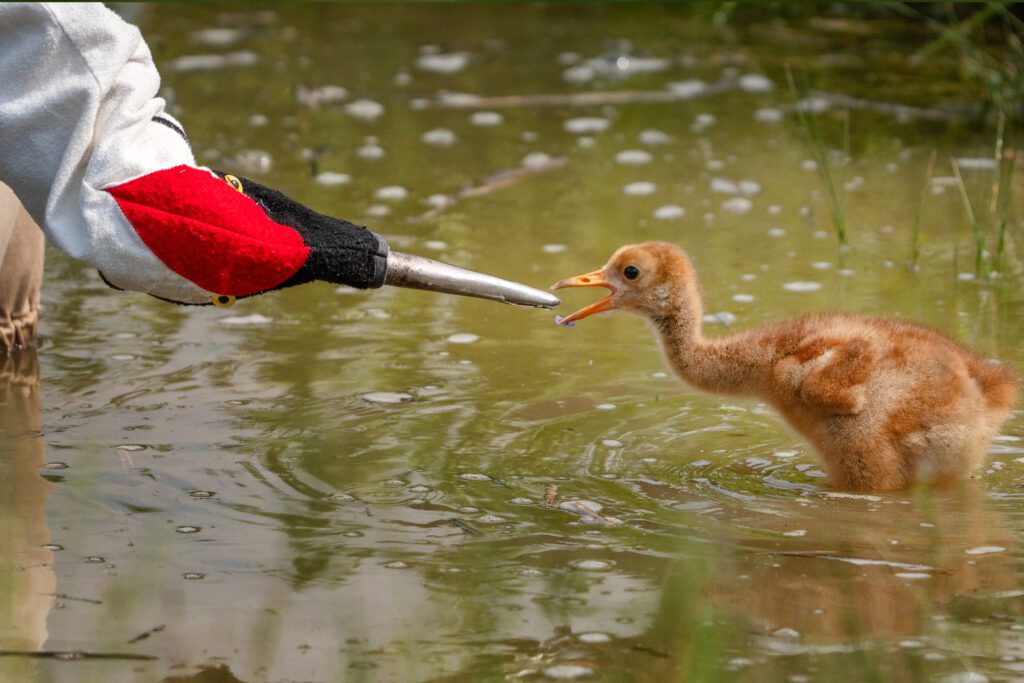Whooping Cranes are back!
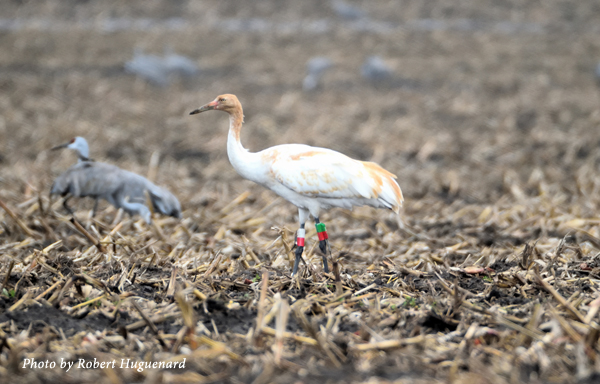
Whooping Crane 72-17, or Amethyst, rests during migration at Jasper-Pulaski Fish and Wildlife Area in northern Indiana. Amethyst was reared at our headquarters this summer by adult cranes – known as parent-rearing – and was released in Wisconsin this fall near wild cranes. The young crane began migration with Sandhill Cranes on Nov. 16, 2017, and arrived in Florida four days later!
If you look closely, you may see a Whooping Crane among the thousands of Sandhill Cranes that are migrating south this month across the United States. Whooping Cranes are quickly returning to their wintering areas in the southeastern United States and Texas, including our project areas in Indiana, Alabama and the central Texas coast.
Last year over half of the Eastern Migratory Whooping Crane population that summers in Wisconsin used Indiana as either a migration stopover site or a wintering area. The best place to see Whooping Cranes in Indiana is at Goose Pond Fish and Wildlife Area near Linton, Indiana, about one hour west of Bloomington. The first two Whooping Cranes arrived in late October – a pair identified as 18-03 (male) and 36-09 (female). This pair is consistently the first to arrive, and the last to leave Indiana. They are often visible from the visitor center at Goose Pond Fish and Wildlife Area.
On Nov. 13, three Whooping Cranes returned to Wheeler National Wildlife Refuge in northern Alabama, and more are expected to arrive soon. Two of the cranes, 01-11 and 59-13, are a young pair known as Beau and Latka (the female hatched at our headquarters in 2013!). The third crane was hatched in 2015 and has not been recorded before at the refuge. The three birds were first sighted in a field with about 1,500 Sandhill Cranes.
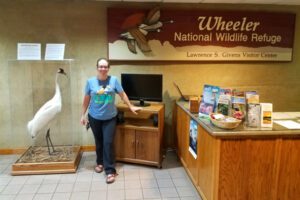
This winter we have a staff person both in Indiana and Alabama conducting outreach programs near the Whooping Cranes’ wintering areas. The staff are reaching out to Audubon groups, community organizations, refuge visitors, and sportsmen and women to share information about Whooping Crane conservation and identification. Our goal is to develop communities that care about Whooping Cranes and take pride in having this endangered species as a neighbor.
The first Whooping Cranes arrived at the Aransas National Wildlife Refuge in coastal Texas in late October. Our staff conducted a crane habitat survey at the Aransas National Wildlife Refuge in early November and observed 34 Whooping Cranes on their wintering grounds. Among the returning cranes were three families with a single juvenile each and a single parent with two juveniles. Most of the cranes were feeding in the coastal marsh that is full of wolfberry fruits, an important food for the cranes that has recovered after Hurricane Harvey made landfall near the refuge this summer.
Our staff in Texas are continuing to monitor the Whooping Cranes’ habitat as the cranes return to Texas. Initial results show that the salinity has risen in the inland freshwater ponds used by the cranes. We are working with our Texas partners to repair solar pumps that supply freshwater to these critical ponds. The pumps were damaged by the winds and storm surge as Harvey moved across the central coast.
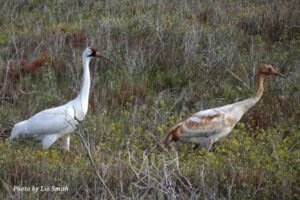
The Whooping Crane’s recovery is one of conservation’s most inspiring stories. Back from the brink of extinction, Whooping Cranes are making a steady comeback from about 20 individuals in the 1940s to approximately 500 birds in the wild today. Named for their loud and distinctive calls, Whooping Cranes once lived throughout much of North America.
The population in Texas is growing at a steady rate, with 63 chicks reported on the birds breeding grounds in Canada this summer. In the Eastern Migratory population, in addition to two wild-hatched chicks, 11 parent-reared chicks, and 7 costume-reared chicks hatched at our headquarters and the Patuxent Wildlife Research Center in Maryland were released this fall (click here to learn more about the rearing methods). The parent-reared chicks were released one or two at a time, across four counties in Wisconsin near adult Whooping Cranes. The first parent-reared chick started migration in early November. We will monitor the chicks as they complete their first migration and learn more about the habitats they select and whether they continue to associate with adult Whooping Cranes.
How you can help
You can help protect the Endangered Whooping Crane by learning a few identifying characteristics. Whooping Cranes have a white body, red on top of their head and black marks running along their cheeks and throat. They also have black wing tips.
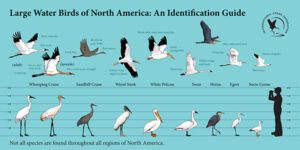
Give Whooping Cranes space and appreciate them from afar. If you encounter a Whooping Crane in the wild, please give them the respect and distance they need. Do not approach birds on foot within 200 yards. Remain in your vehicle and get no closer than 100 yards. Also, please remain concealed and do not speak loudly enough that the birds can hear you. Finally, do not trespass on private property in an attempt to view or photograph Whooping Cranes. Click here to report a Whooping Crane sighting.


